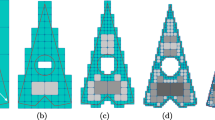Abstract
Structured and semi-structured (a.k.a. swept or extruded) hexahedral meshes are used in many types of engineering analysis. In finite element analysis, regions of structured and semi-structured mesh are often connected in an unstructured manner, preventing the use of a globally consistent parametric space to represent these meshes. This paper describes a method for mapping between the parametric spaces of such regions, and methods for representing these regions and interfaces between them. Using these methods, a 57% reduction in mesh storage cost is demonstrated, without loss of any information. These methods have been implemented in the MOAB mesh database component, which provides access to these meshes from both structured and unstructured functions. The total cost for representing structured mesh in MOAB is less than 25 MB per million elements using double-precision vertex coordinates; this is only slightly larger than the space required to store vertex coordinates alone.







Similar content being viewed by others
References
CFD general notation system standard interface data structures, document ver 2.3.5. Draft AIAA recommended practice R-101A-200X. Available at http://www.grc.nasa.gov/WWW/cgns/sids/sids.pdf
Brown DL (2002) Overture software for solving PDEs in complex geometry. In: A workshop on the ACTS collection, Berkeley, California, September 2002, UCRL-PRES-150012
Chombo: adaptive mesh refinement library. Available at http://www.seesar.lbl.gov/anag/chombo/
Parashar M, Browne JC (2000) Systems engineering for high performance computing software: the HDDA/DAGH infrastructure for implementation of parallel structured adaptive mesh refinement, IMA vol 117. Structured adaptive mesh refinement (SAMR) grid methods
Blacker TD et al (1994) CUBIT mesh generation environment, vol 1: user’s manual’, SAND94-1100, Sandia National Laboratories, Albuquerque, New Mexico. Available at http://sass1693.sandia.gov/cubit/release/doc-public/Cubit_UG-4.0.pdf
Gambit, Fluent Inc. http://www.fluent.com/software/gambit
White D, Mingwu L, Benzley S, Sjaardema G (1995) Automated hexahedral mesh generation by virtual decomposition. In: Proceedings of the 4th international meshing roundtable, Albuquerque, New Mexico, October 1995. Sandia National Laboratories, SAND95-2130
White DR, Tautges TJ (2000) Automatic scheme selection for toolkit hex meshing. Int J Numer Methods Eng 49:127–144
Tautges TJ, Meyers RE, Merkley K, Stimpson C, Ernst C (2004) MOAB: a mesh-oriented data base. Sandia National Laboratories report, Sandia National Laboratories, Albuquerque (to appear)
Mortenson ME (1985) Geometric modeling. Wiley, New York
The Terascale Simulation Tools and Technology (TSTT) Center. Home page at http://www.tstt-scidac.org/
SCIDAC: scientific discovery through advanced computing. Home page at http://www.scidac.org/
White D, Saigal S, Owen S (2003) CCsweep: automatic decomposition of multi-sweep volumes. In: Proceedings of the 4th symposium on trends in unstructured mesh generation, Albuquerque, New Mexico, July 2003
Lai M, Benzley SE, White DR (2000) Automated hexahedral mesh generation by generalized multiple source to multiple target sweeping. Int J Numer Methods Eng 49:261–275 (2000)
Acknowledgements
The author wishes to acknowledge Karl Merkley, Ray Meyers, Clint Stimpson, and Corey Ernst at Elemental Technologies, Inc., for their great work implementing other parts of MOAB, on which this work is based. We also wish to acknowledge Mike Heroux of Sandia National Laboratories for his quick derivation of the inverse transform matrix described in Section 4.
Author information
Authors and Affiliations
Corresponding author
Additional information
Sandia is a multiprogram laboratory operated by Sandia corporation, a Lockheed Martin company, for the United States department of energy under contract DE-AC04-94AL85000. This work was performed under the auspices of the U.S. Department of Energy, Office of Advanced Scientific Computing, SciDAL program.
Rights and permissions
About this article
Cite this article
Tautges, T.J. MOAB-SD: integrated structured and unstructured mesh representation. Engineering with Computers 20, 286–293 (2004). https://doi.org/10.1007/s00366-004-0296-0
Received:
Accepted:
Published:
Issue Date:
DOI: https://doi.org/10.1007/s00366-004-0296-0




